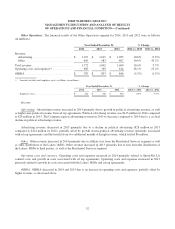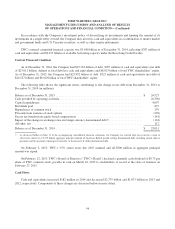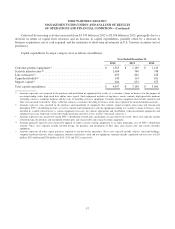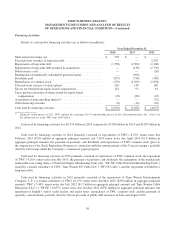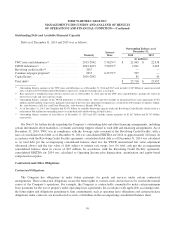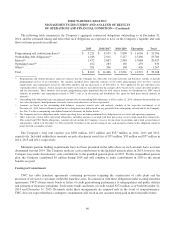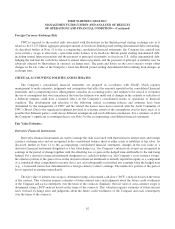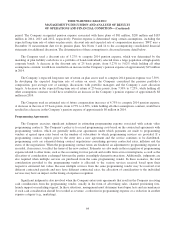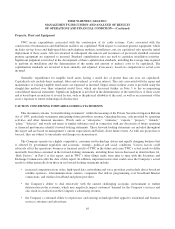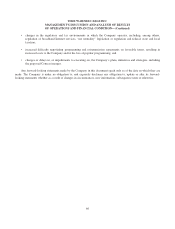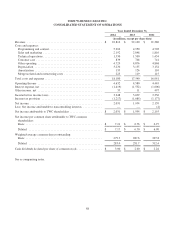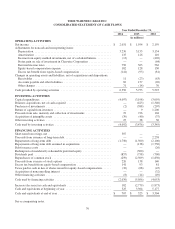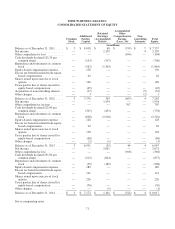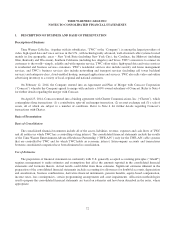Time Warner Cable 2014 Annual Report Download - page 70
Download and view the complete annual report
Please find page 70 of the 2014 Time Warner Cable annual report below. You can navigate through the pages in the report by either clicking on the pages listed below, or by using the keyword search tool below to find specific information within the annual report.TIME WARNER CABLE INC.
MANAGEMENT’S DISCUSSION AND ANALYSIS OF RESULTS
OF OPERATIONS AND FINANCIAL CONDITION—(Continued)
Foreign Currency Exchange Risk
TWC is exposed to the market risks associated with fluctuations in the British pound sterling exchange rate as it
relates to its £1.275 billion aggregate principal amount of fixed-rate British pound sterling denominated debt outstanding.
As described further in Note 11 to the accompanying consolidated financial statements, the Company has entered into
cross-currency swaps to effectively convert the entire balance of its fixed-rate British pound sterling denominated debt,
including annual interest payments and the payment of principal at maturity, to fixed-rate U.S. dollar denominated debt,
hedging the risk that the cash flows related to annual interest payments and the payment of principal at maturity may be
adversely affected by fluctuations in currency exchange rates. The gains and losses on the cross-currency swaps offset
changes in the fair value of the Company’s fixed-rate British pound sterling denominated debt resulting from changes in
exchange rates.
CRITICAL ACCOUNTING POLICIES AND ESTIMATES
The Company’s consolidated financial statements are prepared in accordance with GAAP, which requires
management to make estimates, judgments and assumptions that affect the amounts reported in the consolidated financial
statements and accompanying notes. Management considers an accounting policy and estimate to be critical if it requires
the use of assumptions that were uncertain at the time the estimate was made and if changes in the estimate or selection of
a different estimate could have a material effect on the Company’s consolidated results of operations or financial
condition. The development and selection of the following critical accounting policies and estimates have been
determined by the management of TWC and the related disclosures have been reviewed with the Audit Committee of
TWC’s Board. Due to the significant judgment involved in selecting certain of the assumptions used in these areas, it is
possible that different parties could choose different assumptions and reach different conclusions. For a summary of all of
the Company’s significant accounting policies, see Note 3 to the accompanying consolidated financial statements.
Fair Value Estimates
Derivative Financial Instruments
Derivative financial instruments are used to manage the risks associated with fluctuations in interest rates and foreign
currency exchange rates and are recognized in the consolidated balance sheet as either assets or liabilities at fair value. As
discussed further in Note 11 to the accompanying consolidated financial statements, changes in the fair value of a
derivative financial instrument designated as a fair value hedge (e.g., the Company’s interest rate swaps) are recognized in
earnings in the period of change together with the offsetting loss or gain on the hedged item attributable to the risk being
hedged. For a derivative financial instrument designated as a cash flow hedge (e.g., the Company’s cross-currency swaps),
the effective portion of the gain or loss on the derivative financial instrument is initially reported in equity as a component
of accumulated other comprehensive income (loss), net, and subsequently reclassified into earnings when the hedged item
(e.g., a forecasted transaction denominated in a foreign currency) affects earnings. The ineffective portion of the gain or
loss is reported in earnings immediately.
The fair value of interest rate swaps is determined using a discounted cash flow (“DCF”) analysis based on the terms
of the contract. This valuation requires estimates of future interest rates and judgments about the future credit worthiness
of the Company and each counterparty over the terms of the contracts. Similarly, the fair value of cross-currency swaps is
determined using a DCF analysis based on the terms of the contracts. This valuation requires estimates of future interest
rates, forward exchange rates and judgments about the future credit worthiness of the Company and each counterparty
over the terms of the contracts.
62


